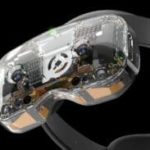Snap Inc’s AR Spectacles glasses are nothing short of black magic.
First announced back in 2016, Snap Inc.’s offbeat smart glasses have seen several different iterations over the past five and a half years, each one improving upon the last with new features designed to merge the company’s social media platform with the real world. The latest Spectacles design was the first to include built-in AR (augmented reality) functionality, allowing the wearer to interact with existing Snapchat AR Lenses straight from the glasses in real-time.
The glasses aren’t available for purchase at the moment. Snap has opted instead to distribute hardware to a select group of creators familiar with Lens Studio, the company’s Lens-building software. Unlike the headset, Lens Studio is available to the public and 100% free of charge. While the company is best known for its social media app, Lens Studio has quietly become one of the largest areas of focus for the company. The AR Spectacles feel almost like a conduit, harnessing the power of the platform to deliver some of the most impressive AR experiences I’ve tried to date.
Not too long ago I was invited by Snap to try the Spectacles out for myself in Beverly Hills. Upon arriving, the team gave me a brief rundown of the many different projects built using the Lens Studio platform. This included Michael Nicoll, founder of BLNK and one of the first Lens Studio creators to experiment with the recently released Custom Landmark feature which allows multiple users to scan and interact with famous real-world locations around the world. Nicoll has created numerous music-based filters on the Snapchat platform for a number of high-profile clients, including Megan Thee Stallion.
After the quick introduction, I was presented with a pair of AR Spectacles straight from the box. At first glance, you could easily mistake the Spectacles for a pair of fashion-forward sunglasses. Unlike existing AR headsets such as the Magic Leap 2 or Microsoft HoloLens, the Spectacles feature a discrete, light-weight design more akin to glasses than a headset.
The device features foldable arms that allow for easy storage in the accompanying charging case. Two dual waveguide displays provide impressive AR visuals in real-time. The headset also features two front-facing cameras for capturing video and images, stereo speakers, touch controls that allow you to cycle through Lenses as well as scan the environment for Lens suggestions, WiFi connectivity with a paired smartphone app, and a USB-C port for charging.

Trying the device out for myself, I was blown away by the quality of the AR visuals. Each display offers 2,000 nits of brightness, resulting in ultra-clear 3D images that blend seamlessly with the real-world environment, which means no more of those annoying semi-translucent graphics. The only thing more impressive than the graphics was the tracking. In order to get the full experience, the team carved out an area outside for me to stretch my legs.
One Lens had me running for my life as a cartoon zombie chased me throughout the backyard. Despite my rapid head movements, the AR character moved consistently throughout the real world, even when I almost slipped and fell head-first into the pool. Another Lens had me interacting with an AR art project using the device’s built-in hand-tracking capabilities. While I found the experience a bit wonky at times, it was still an impressive use of the technology, one I hope to see expanded upon in future iterations.
Unfortunately, hand-tracking isn’t the only limitation I found with the device. Speaking with the team, I learned that the AR Spectacles have an average battery life of about 30 minutes. Needless to say, this is an incredibly short amount of time, even for an immersive technology device. That said, the accompanying case does allow for quick and easy wireless charging. I also found the overall field of view to be relatively underwhelming. The AR visuals only cover about half of the display, which can easily take you out of the experience.

That said, many of these issues are common among current AR headsets and glasses. As the technology continues to improve so too can you expect the overall quality and convenience. The amount of tech Snap has been able to jam into this sleek-looking device is nothing short of amazing. Moving forward, we’ll be keeping an extremely close eye on the company as it continues to advance upon its already stellar Lens Studio and Spectacles technology.
As previously mentioned, Snap this month made its Custom Landmarkers technology available to all creators via Lens Studio, allowing you to create immersive AR experiences tied directly to real-world locations. Previous creators used the technology to anchor their AR creations to famous structures like the Gateway of India and the Great Sphinx of Giza in Egypt. Now anyone can begin creating AR Lenses for their local areas.
Image Credit: Snap Inc.
The post We Tried Snap’s AR Glasses And Had Our Minds Blown appeared first on VRScout.





